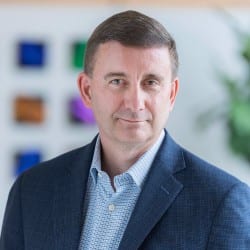
FinancialForce has been through several iterations of messaging in recent years. How would you describe FinancialForce today?
“It’s to provide a market-leading platform for service-oriented companies to drive their digital transformation. So many of these companies are going through digital transformations today, and they’re struggling with how they can actually have unified processes and ways they show up for their customers. We provide the software and platform to allow them to do that exceptionally well.”
What do you want FinancialForce to be famous for?

“What I say to the team is, we want to build a company that we can all look back on as one of the great companies in the history of IT. That’s not measured by us, but it’s measured by our customer NPS and how they feel about us in terms of our importance to their business.
“It’s how they feel about the importance that we play in their environment. We are the system of record for incredibly big, complex, and important businesses and people depend on every day. When I meet with customers, I give every customer my mobile phone number, and I tell them they can call me anytime, and they do. We have a relationship with them that transcends the long term.”
On progress
Where is FinancialForce now on its growth path?
“We added 250 employees in the last year. Our bookings growth rate last year was about 50%. We’re continuing to grow aggressively. We’re continuing to hire aggressively, whereas a lot of the tech companies have pulled back based on what’s happening in the market. We opened a new large centre in Austin, Texas, and Utrecht (Netherlands) and we’ll have a second Bay Area office opening in San Jose.”
What are the key achievements this year so far?
“We moved to an even more aggressive R&D stance. I’ve increased the percentage of our spend on R&D in terms of real dollars and as a percentage of our overall revenue. We’ve gone from two major releases a year to three major releases a year. The feature velocity, what we see coming out into the marketplace with now three releases a year, is pretty amazing.
“I’m really pleased with the uptake of our three new products. We hadn’t had new products in a while. So Services CPQ, CS cloud, and then the FP&A product for budgeting. All three of those have taken off beautifully. We have great early adopter customers. We have a great pipeline and a lot of momentum in all those areas.”
What do you hope to achieve in the rest of the year?
“We have a lot on our plate in terms of R&D and will continue hiring on the sales and marketing side. We’re continuing to move upmarket into many new spaces that we think will be great for us. We are planning more international expansion. In our last release, there were a lot of localizations for additional countries. We’re beginning to staff in those countries, and our go-to-market is increasing. We’re beginning to see our first set of deals in those countries.”
What about competitors?
As you move upmarket and expand globally, are you seeing a new set of competitors?
“It depends on the market space that you’re referring to. We’ve different competitors, depending on the market space we’re in. We don’t see anybody globally on the high end of professional services automation. We don’t have any competitors that can work at the scale of tens of thousands of users with the same level of complexity. There are traditional competitors like a Sage Intact and NetSuite in the ERP space.
“When you look at customer success, our approach is very different to a Gainsight or Totango. Ours is very much leveraging all the capabilities our customers have today around things like PSA, financials and project management. We’re also able to run the customer success motion through best practices, playbooks, and milestone-based activities. I don’t see us competing against traditional customer success platforms.”
People challenges are top of mind
What are your challenges?
“The number one challenge has been hiring. That’s been an industry-wide phenomenon. We won’t lower the standard of what we want to see, whether it’s a sales executive, an account executive, a development engineer, or somebody in supporting teams. We have a great culture inside the business and want to ensure we bring the right quality people in. The number one issue is that we’ve never been able to keep up with the hiring plan I put forward for the company.”
As you mentioned, you are opening offices. Has remote working had an impact on the ability to hire?
“Certainly, the ability to work remotely has helped a great deal. You have to do remote work when it makes sense. For example, the hubs we built in Austin and London are principally more of an inside or a velocity sales motion. In those situations, you want the people to be in the office together.
“The account executive, the systems engineer, the customer success manager, and the BDR can all swivel seats and talk to each other and work together. In those situations, we want to hire locally so that people can be in the office together.
“In other situations, we absolutely embrace folks working remotely. We have a lot of people that are in roles that are well served by technology. That will continue to be an important aspect of how we recruit. But, it’s not a one-size-fits-all; there will be many hybrid working environments in the future. In our environment, it comes down to a conversation between you and your manager on what makes sense for your role.”
New development teams?
You have development teams in Harrogate and Grenada. Are you looking to extend that model to other, perhaps more cost-effective locations?
“We are extremely pleased with the model that we have in Grenada. Obviously, there’s a very strong local university that we hire aggressively from, and we have a similar model in Harrogate in the UK. What’s really interesting about these locations is if you create a strong, early in career hiring programme, you can bring people in that are incredibly bright and talented and develop them up through your organisation.
“If we look at the managers and the leaders within our development organisation, over 70% of them came up through our system. Yes, we will be looking at other places if we don’t have the ability to scale as fast as we want to in Harrogate and Grenada.”
What are your personal challenges?
“My biggest challenge is to make sure that I do a good job of balancing the importance of employee safety and health along with pivoting to a return to in-person activities and events.”
The book question
What was the latest book you read? And what was your takeout from it?
“There’s a book called Breathe (by James Nestor (Amazon Aus, UK, US) that was actually provided to me by one of my investors, and it was just a terrific read. It’s about the importance of breath and the importance that it’s had to people over the ages and how as we evolved as a human species.
“Our physiology actually became worse in our ability to take advantage of breath and what things you can do to improve taking advantage of using breath as a tool in your life, to make you healthier and better.”


























